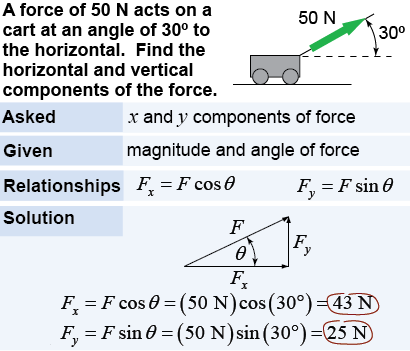|
The properties of right triangles are the key to resolving a vector into components. In the vector diagram for a 10 N force, the x-component is the projection of the vector along the x-axis. The y-component is the projection along the y-axis. These projections are the sides of the right triangle formed by F, Fx, and Fy. The hypotenuse of the triangle is the original force F. 
|

|
The ratios of the sides of a right triangle depend only on the angle and are called sine, cosine, and tangent. In the example above, the force F makes an angle θ with the x-axis. The cosine of the angle is the ratio of the adjacent side divided by the hypotenuse: cos θ = Fx / F. The sine of the angle is the ratio of the opposite side divided by the hypotenuse, or sin θ = Fy / F. The tangent of the angle is the ratio of the opposite side divided by the adjacent side, or tan θ = Fy / Fx. 
|

|
| (6.2) | | | F | = | magnitude of force (N) | | Fx | = | x-component of force (N) | | Fy | = | y-component of force (N) | | θ | = | position angle (degrees) |
| Force vector
x- and y- components |
|
 In the equations above one assumes that the angle θ is measured from the x-axis. If instead the angles are measured from the y-axis, then the sine and cosine functions in these equations will swap places. The sine and cosine relationships can be solved for the components Fx and Fy in terms of the magnitude and angle of the original force. Because the sides of a right triangle can never be longer than the hypotenuse, the values of sine and cosine are always between 0 and 1 for angles that lie between 0° and 90°. Sine and cosine can be negative for other angles but can never have a value greater than +1 or less than −1.
In the equations above one assumes that the angle θ is measured from the x-axis. If instead the angles are measured from the y-axis, then the sine and cosine functions in these equations will swap places. The sine and cosine relationships can be solved for the components Fx and Fy in terms of the magnitude and angle of the original force. Because the sides of a right triangle can never be longer than the hypotenuse, the values of sine and cosine are always between 0 and 1 for angles that lie between 0° and 90°. Sine and cosine can be negative for other angles but can never have a value greater than +1 or less than −1. 
|
| |
|

